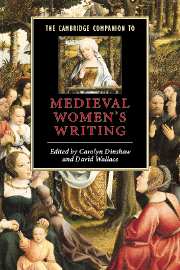5 - Between women
from Part I - Estates of women
Published online by Cambridge University Press: 28 May 2006
Summary
The tripartite division of medieval women into the categories of virgin, wife, and widow screens out the very possibility of female fellowship, community, and even love. Under the system derived from patristic sources, women were classified by their sexual/marital status, and this medieval distinction had the effect of rendering relationships between women a meaningless or even illegible aspect of femininity. Female interactions simply did not register on the medieval radar screen, and as a result, they slip through scholarly studies as well. Where were the women who formed communities with each other, engaged in deep, abiding friendship together, and experienced sexual bonds with other women? The Middle Ages is positively verbose on the topics of male friendship and the dangers of sexual relations between men, and yet it was relatively silent about female friendship and love. One way of understanding this relative silence is to attribute it to the prevailing misogyny of the Middle Ages, which simply took female bonding and sexuality less seriously than it did male bonding and male sexuality. This explanation, however, falls into the trap of granting medieval misogyny hegemonic status in shaping and representing women’s lives. Feminist scholars dealt with a similar problem when they first attempted to discern women and gender issues that the ideologies – past and present – obscured from historical record. What happens when readers and scholars similarly refuse to read medieval texts and study medieval history according to medieval taxonomies of women? Apart from the contexts of female religious communities and spirituality, where might we begin to look for the varied forms of female fellowship that medieval women might create together or that medieval texts might represent?
- Type
- Chapter
- Information
- The Cambridge Companion to Medieval Women's Writing , pp. 70 - 88Publisher: Cambridge University PressPrint publication year: 2003
- 2
- Cited by



